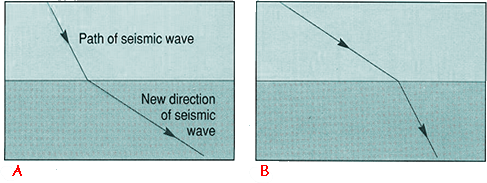|
Geologists also
use the idea of refraction to locate rock boundaries. Refraction occurs
when a wave passes from one medium to another. The result is that the
wave bends.
By knowing the
initial direction of the seismic wave and where it ends up, geologists
not only learn that a different type of rock layer is present but also
learn the relative density of each layer. Geologists can also use this
information to tell where fault lines lie. Using these ideas, scientists
have learned that the Earth's crust and much of the mantle are solid.
When dealing with light we speak of the path of light energy as a 'ray'. For the following diagrams let us think of the seismic energy in the same way - as a 'ray'.

Rays 'bend towards
the normal' when they 'slow down'. In solids, the denser the material,
the faster the vibrations travel. Therefore if the 'ray' bends towards the normal it is going into a less dense material.
Therefore in A the wave is speeding
up and the darker area must be denser rock. In B it is the other way round!
|